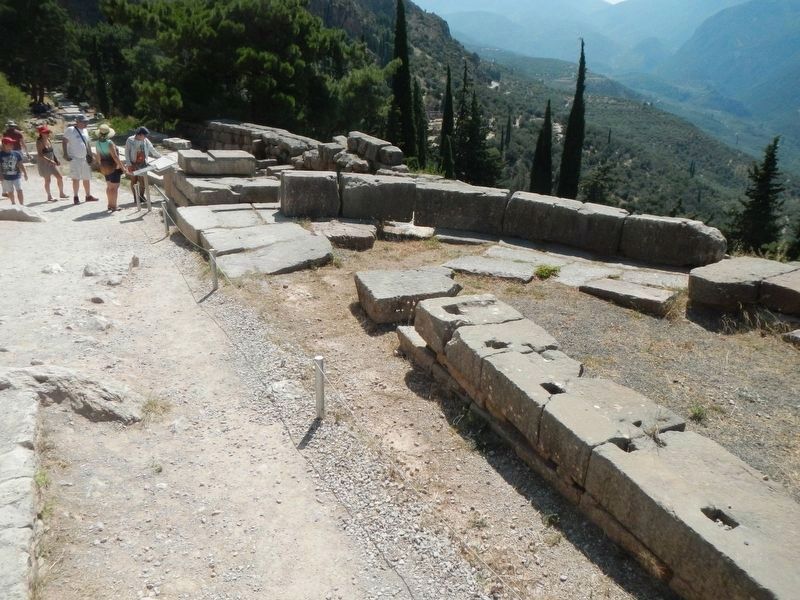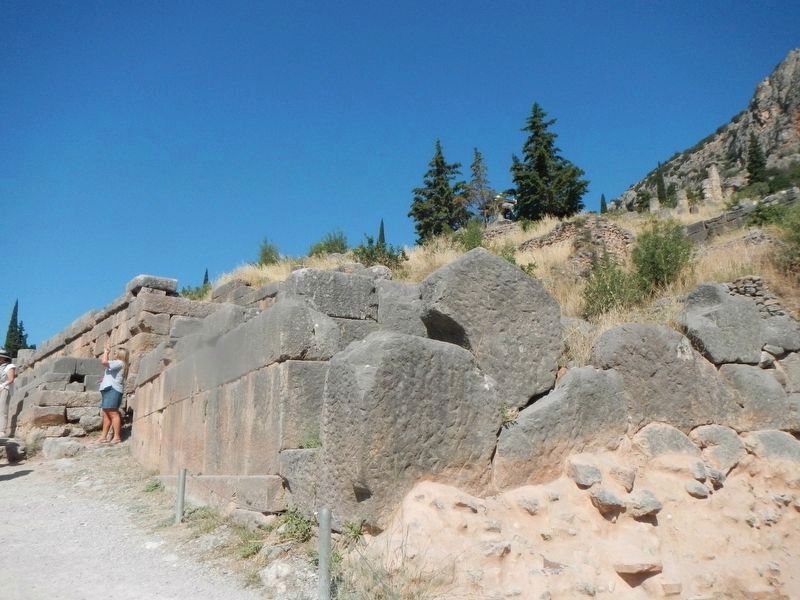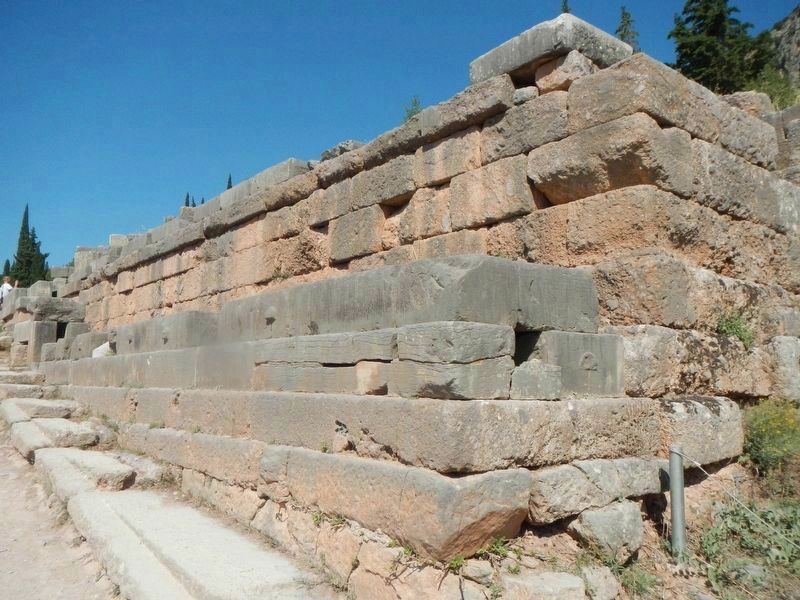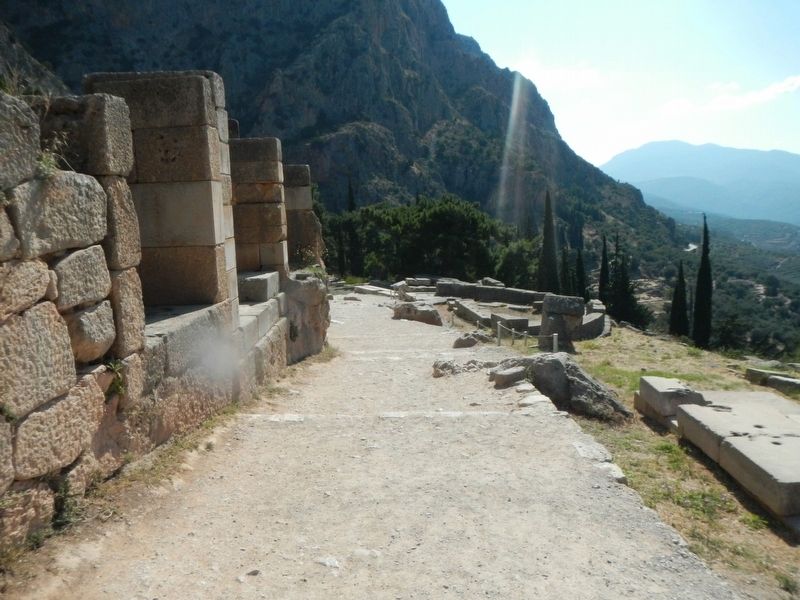Delfi in Phocis, Thessaly and Central Greece, Greece — Ελλάδα (Southeastern Europe, Balkan Peninsula)
Monuments of the Sacred Way
MNHMEIA THΣ IEPAΣ OΔOY
— Monuments de la Voie Sacrée —
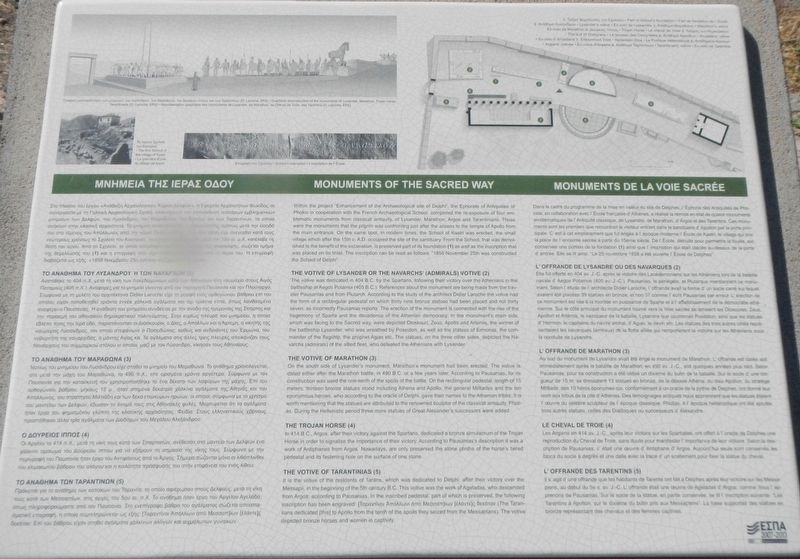
Photographed By Barry Swackhamer, July 21, 2018
1. Monuments of the Sacred Way Marker
Captions: (upper left) Graphical reconstruction of the monuments of Lysander, Marathon, Trojan Horse, Tarantinians; (lower left, 2, left and right) The first School of the village of Kastri, School's inscription; (upper right) ➊ Part of the School's foundation, ➋ Lysander's votive, ➌ Marathon's votive, ➍ Trojan Horse ➎ The bull of Corkyrans, ➏ Arcadiaris' votive, ➐ Hellenistic Stoa, ➑ Argians votives, ➒ Tarantiniaris' votives.
English:
Within the project "Enhancement of the Archaeological site of Delphi", the Ephorate of Antiquities of Phokis in cooperation with the French Archaeological School, competed the re-exposure of four emblematic monuments from classical antiquity, of Lysander, Marathon, Argos and Taranatinians. Those were the monuments that the pilgrim was confronting just after the access to the temple of Apollo from the main entrance. On the same spot, in modern times, the School of Kastri was erected, the small village which after the 15th c. A.D. occupied the site of the sanctuary. From the School, that was demolished to the benefit of the excavation, is preserved part of its foundation (1) as well as the inscription that was placed on its lintel. The inscription can be read as follows: "1858 November 25th was constructed the School of Delphi".
The Votive of Lysander or the Navarchs' (Admirals) Votive (2)
The votive was dedicated in 404 B.C. by the Spartans, following their victory over the Athenians in the battleship (ship battle ?) at Aegos Potamoi (405 B.C.). Reverences about the monument are being made from the traveler Pausanias and from Plutarch. According to the study of the architect Didier Laroch the votive had the form of a rectangular pedestal on which thirty nine nine bronze statues had been placed and not thirty seven as incorrectly Pausanias reports. The erection of the monument is connected with the rise of the hegemony of Sparta and the decadence of the Athenian democracy. In the monument's main side which was facing to the Sacred way, were depicted Dioskouri, Zeus, Apollo and Artemis, the winner of the battleship (ship battle ?) Lysander, who was wreathed by Poseidon, as well as the statue of Ermonas, the commander of the flagship, the prophet Agias etc. The statues, on the three other side, depict the Navarchs (admirals) of the allied fleet, who defeated the Athenians with Lysander.
The Votive of Marathon (3)
On the south side of Lysander's monument, Marathon's monument had been erected. The votive is dated either after the Marathon battle, in 490 B.C, or a few years later. According to Pausanias, for its construction was used the one-tenth of the spoils of the battle. On the rectangular pedestal, length of 15 meters, thirteen bronze statues stood including Athena and Apollo, the general Miltiades and the ten eponymous heroes, who according to the oracle of Delphi, gave their names to the Athenian tribes. It
is worth mentioning that the statues are attributed to the renowned sculptor of the classical antiquity, Phidias. During the Hellenistic period three more statues of Great Alexander's successors were added.
The Trojan Horse (4)
In 414 B.C., Argos, after their victory against the Spartans, dedicated a bronze simulacrum of the Trojan Horse in order to signalize the importance of their victory. According to Pausanias's description it was a work by Antiphanes from Argos. Nowadays, are only preserved the stone plinths of the horse's tiered pedestal and its fastening hole on the surface of one stone.
The Votive of Tarantinias (5)
It is the votive of the residents of Tarans, which was dedicated to Delphi, after their victory over the Messapii, in the beginning of the 5th century B.C. This votive was the work of Ageladas, who descended from Argos, according to Pausanias. In the inscribed pedestal, part of which is preserved, the following inscription has been engraved: ... (The Tarantians dedicated (this) to Apollo from the tenth of the spoils they seized from the Messapians). The votive depicted bronze horses and women in captivity.
Erected by Greek Ministry of Culture and Sports.
Topics. This historical marker is listed in these topic lists: Anthropology & Archaeology • Education • Man-Made Features.
Location. 38° 28.916′ N, 22° 30.146′ E. Marker is in Delfi, Thessaly and Central Greece, in Phocis. Marker is on EO Livadias Amfissa (Route EO 48), on the left when traveling east. Touch for map. Marker is in this post office area: Delfi, Thessaly and Central Greece 330 54, Greece. Touch for directions.
Other nearby markers. At least 8 other markers are within walking distance of this marker. The Roman Agora (within shouting distance of this marker); The Sanctuary of Apollo (within shouting distance of this marker); The Archaeological Site of Delphi (within shouting distance of this marker); The Halos (within shouting distance of this marker); The Treasury of the Sikyonians and Siphnians (about 90 meters away, measured in a direct line); The Navel (about 90 meters away); The Temple of Apollo (about 90 meters away); The Altar of Chiots Area (about 90 meters away). Touch for a list and map of all markers in Delfi.
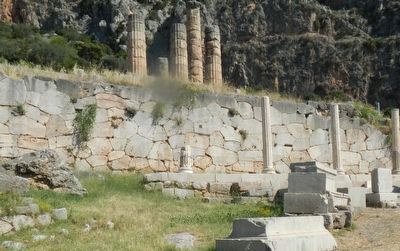
Photographed By Barry Swackhamer, July 21, 2018
6. Polygonal wall
The retaining wall was built to support the terrace housing the construction of the second temple of Apollo in 548 BC. Its name is taken from the polygonal masonry of which it is constructed. At a later date, from 200 BC onwards, the stones were inscribed with the manumission contracts of slaves who were consecrated to Apollo. Approximately a thousand manumissions are recorded on the wall. -- Wikipedia
Credits. This page was last revised on March 22, 2022. It was originally submitted on November 13, 2018, by Barry Swackhamer of Brentwood, California. This page has been viewed 551 times since then and 83 times this year. Photos: 1, 2, 3, 4, 5, 6. submitted on November 13, 2018, by Barry Swackhamer of Brentwood, California.
